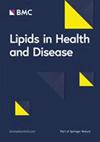空腹血脂和血糖浓度与 ALT 水平之间的密切联系随着 ALT 量级的增加而加强
IF 3.9
2区 医学
Q2 BIOCHEMISTRY & MOLECULAR BIOLOGY
引用次数: 0
摘要
持续的氧化还原状态以及碳水化合物和脂质代谢过程中过量的活性物质会导致肝脏氧化损伤,然而,空腹血浆中脂质和葡萄糖的浓度与空腹血丙氨酸转氨酶(ALT)和天门冬氨酸转氨酶(AST)水平的关系如何,仍有待在大规模人群中进行评估。本研究对 182,971 名年龄在 18 至 92 岁之间的居民进行了横断面研究;采用了多维分层分析,包括定量线性回归分析和性别分层,以提高证据的质量。非高密度脂蛋白胆固醇(HDL-C)和甘油三酯的浓度与谷丙转氨酶(ALT)水平之间呈正相关,在谷丙转氨酶(ALT)水平的每个量级中,男性的相关性更强,且系数随着谷丙转氨酶(ALT)水平的升高而扩大,男性的斜率分别为3.610和5.678,女性的斜率分别为2.977和5.165。高密度脂蛋白胆固醇(HDL-C)浓度与谷丙转氨酶(ALT)水平之间呈负相关,男性在每个量级的相关性也更强,系数随谷丙转氨酶(ALT)水平的升高而扩大,女性的斜率为-7.839,男性为-5.797。葡萄糖浓度与谷丙转氨酶水平之间的关系呈正相关,但在每个量级中,女性的相关性更强,并且随着谷丙转氨酶水平的升高,系数扩大,男性的斜率为 1.736,女性的斜率为 2.177。非高密度脂蛋白胆固醇、甘油三酯和血糖浓度与谷草转氨酶水平之间的系数和斜率也呈类似的模式,相对较弱。白蛋白浓度与血脂和血糖浓度之间的关系在所有量级中都相对稳定。血脂和血糖浓度与肝功能变化之间的剂量依赖效应表明,过度的碳水化合物和脂质代谢可能会导致亚临床肝损伤。肝脏中长期持续产生的原发性和继发性炎症因子可能会传递到心脏、肾脏和肺部等邻近器官,导致和/或加剧这些内脏器官的病理变化。本文章由计算机程序翻译,如有差异,请以英文原文为准。
Strong associations between fasting lipids and glucose concentrations and ALT levels strengthened with increasing ALT quantiles
A persistent redox state and excessive reactive species involved in carbohydrate and lipid metabolism lead to oxidative damage in the liver, however, how fasting plasma concentrations of lipids and glucose are associated with fasting blood levels of alanine transaminase (ALT) and aspartate transaminase (AST) remains to be evaluated in large-scale population. A cross-sectional study with 182,971 residents aged 18 to 92 years; multidimensional stratified analyses including quantile linear regression analysis and sex stratification were adopted to improve the quality of the evidence. The associations between the concentrations of non-HDL-C and triglyceride and ALT levels were positive, stronger in males in each quantile of ALT levels and the coefficients expanded with increasing ALT levels at slopes of 3.610 and 5.678 in males and 2.977 and 5.165 in females, respectively. The associations between the HDL-C concentrations and ALT levels were negative, also stronger in males in each quantile and the coefficients expanded with increasing ALT levels at slopes of -7.839 in females and − 5.797 in males. The associations between glucose concentrations and ALT levels were positive, but stronger in females in each quantile and the coefficients expanded with increasing ALT levels at slopes of 1.736 in males and 2.177 in females, respectively. Similar pattern consist of relatively weaker coefficients and slops were observed between concentrations of non-HDL-C, triglyceride and glucose and AST levels. The associations between albumin concentration and concentrations of blood lipids and glucose were relatively steady across all quantiles. The dose dependent effect between blood concentrations of lipids and glucose and liver function changes suggests that excessive carbohydrate and lipid metabolism may cause subclinical liver damage. Long term sustained primary and secondary inflammatory factors produced in the liver might be transmitted to adjacent organs, such as the heart, kidneys, and lungs, to cause and/or exacerbate pathological changes in these visceral organs.
求助全文
通过发布文献求助,成功后即可免费获取论文全文。
去求助
来源期刊

Lipids in Health and Disease
生物-生化与分子生物学
CiteScore
7.70
自引率
2.20%
发文量
122
审稿时长
3-8 weeks
期刊介绍:
Lipids in Health and Disease is an open access, peer-reviewed, journal that publishes articles on all aspects of lipids: their biochemistry, pharmacology, toxicology, role in health and disease, and the synthesis of new lipid compounds.
Lipids in Health and Disease is aimed at all scientists, health professionals and physicians interested in the area of lipids. Lipids are defined here in their broadest sense, to include: cholesterol, essential fatty acids, saturated fatty acids, phospholipids, inositol lipids, second messenger lipids, enzymes and synthetic machinery that is involved in the metabolism of various lipids in the cells and tissues, and also various aspects of lipid transport, etc. In addition, the journal also publishes research that investigates and defines the role of lipids in various physiological processes, pathology and disease. In particular, the journal aims to bridge the gap between the bench and the clinic by publishing articles that are particularly relevant to human diseases and the role of lipids in the management of various diseases.
 求助内容:
求助内容: 应助结果提醒方式:
应助结果提醒方式:


